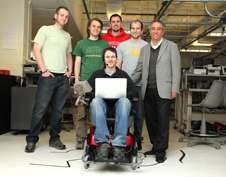Wheelchair follows orders, but can act on its own, too

Five Northeastern University engineering seniors have developed an innovative, voice-operated wheelchair that can navigate through a cluttered room, move alongside walls and detect stairwells and other obstacles in its path — a project, they say, that is designed to enhance the lives of people with a range of physical impairments.
Their work took first place in the Electrical and Computer Engineering Department’s capstone presentations last month. The student team is comprised of Barry Briggs, Dana Lopes, Shane Mulkerrin, Sam Bennett and Thayne Henry, with professor Bahram Shafai serving as their faculty advisor.
“Just knowing that we were working on something that could really make a difference for someone one day helped to boost our determination,” Briggs said.
The user would first memorize a short list of basic voice commands that would move the wheelchair in different directions, stop its movement, and activate and deactivate the system. Speak into a headset, and off goes the wheelchair, obeying the user’s commands via the voice software.
A critical component to the students’ design is an integrated network of ultrasonic distance sensors that detects obstacles ahead and to the side of the wheelchair. The sensors can also determine whether the wheelchair is approaching a significant drop ahead — a set of stairs, for instance. As a safety measure, the system would override user commands to avoid such obstacles.
Under the seat is a universal control unit — what the students call “the heart of the system” — that communicates with the sensor array, and processes and sends the commands to the motor controller to move the wheelchair. Meanwhile, a display panel extending from the right armrest shows users the current direction they are going in, and whether they are approaching any barriers.
The project demonstrates Northeastern’s commitment to use-inspired research, particularly in the University’s top research themes of health, sustainability and security.
While the students based their capstone project around the voice-command control system, they said their universal design would make the wheelchair easy to use and adaptable to work with other command technologies, such as brain-computer interface, eye-tracking, mouth joysticks and hand movement.
“The voice interface is an extremely robust system, and this is a flexible media that can be extremely useful for the physically impaired,” Shafai said. “The students did a fantastic job.”
Provided by Northeastern University



















